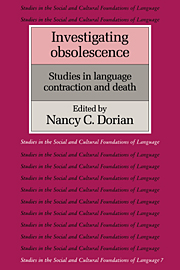Book contents
- Frontmatter
- Contents
- List of maps
- List of contributors
- Preface
- Map
- Dedication
- Introduction
- I Focus on context
- II Focus on structure
- 11 Problems in obsolescence research: The Gros Ventres of Montana
- 12 The structural consequences of language death
- 13 On signs of health and death
- 14 Case usage among the Pennsylvania German sectarians and nonsectarians
- 15 Estonian among immigrants in Sweden
- 16 The incipient obsolescence of polysynthesis: Cayuga in Ontario and Oklahoma
- 17 Urban and non-urban Egyptian Nubian: Is there a reduction in language skill?
- 18 Some lexical and morphological changes in Warlpiri
- 19 Language contraction and linguistic change: The case of Welland French
- 20 Lexical innovation and loss: The use and value of restricted Hungarian
- III Invited commentaries
- Bibliography
- Index of languages
- General index
18 - Some lexical and morphological changes in Warlpiri
Published online by Cambridge University Press: 08 January 2010
- Frontmatter
- Contents
- List of maps
- List of contributors
- Preface
- Map
- Dedication
- Introduction
- I Focus on context
- II Focus on structure
- 11 Problems in obsolescence research: The Gros Ventres of Montana
- 12 The structural consequences of language death
- 13 On signs of health and death
- 14 Case usage among the Pennsylvania German sectarians and nonsectarians
- 15 Estonian among immigrants in Sweden
- 16 The incipient obsolescence of polysynthesis: Cayuga in Ontario and Oklahoma
- 17 Urban and non-urban Egyptian Nubian: Is there a reduction in language skill?
- 18 Some lexical and morphological changes in Warlpiri
- 19 Language contraction and linguistic change: The case of Welland French
- 20 Lexical innovation and loss: The use and value of restricted Hungarian
- III Invited commentaries
- Bibliography
- Index of languages
- General index
Summary
Introduction
The first point I would like to stress in this chapter is that Warlpiri is not yet a dying language. The positive attitudes of the Warlpiri people towards their language and way of life encourage language maintenance. However, the young people are attracted by aspects of the non-Aboriginal way of life. The adoption of new ways, together with exposure to the English language, have led to changes in the language. There are many changes taking place quite rapidly, particularly in the language of the young people. Given statements that are frequently made in the Australian context, statements to the effect that all Aboriginal languages will soon have died out, it is worthwhile to point out some of the changes in progress that we have observed in the speech of the people in the community, particularly in that of the children. The data I will use in the paper have been collected as part of a longterm project on the children's acquisition of Warlpiri as a first language.
In this chapter I will discuss two major aspects of the changes in progress. One is the borrowing of lexical items from English; these borrowings are for both new and existing concepts, and what is of particular interest is the replacement of traditional words with English borrowings as well as the assimilation of the loanwords into the Warlpiri system. It is not unusual to find lexical borrowings when two languages are in contact. Dorian (1986c:259), for example, states that English words have been readily taken into East Sutherland Gaelic and adapted to the Gaelic grammar and morphophonology.
- Type
- Chapter
- Information
- Investigating ObsolescenceStudies in Language Contraction and Death, pp. 267 - 286Publisher: Cambridge University PressPrint publication year: 1989
- 5
- Cited by



